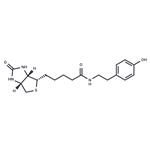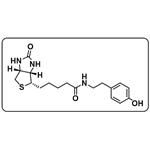Description
Biotinyl tyramide is a reagent that has been used for tyramide signal amplification (TSA)
via catalyzed reporter deposition (CARD). In CARD, a reporter enzyme, such as horseradish peroxidase (HRP) conjugated to a secondary antibody, is bound to the target of interest and catalyzes the covalent deposition of biotinyl tyramide to the sample. The sample is then probed by a detector, such as streptavidin-HRP, allowing detection
via chromogenic or fluorescent methods. Biotinyl tyramide has been used in immunohistochemistry, ELISA, Western blot, and
in situ hybridization applications.
Uses
Biotinyl Tyramide is a Biotin (B389040) derivative, a growth factor present in minute amounts in every living cell. Plays an indispensable role in numerous naturally occurring carboxylation reactions. Occurs mainly bound to proteins or polypeptides. The richest sources are liver, kidney, pancreas, yeast, and milk. The biotin content of cancerous tumors is higher than that of normal tissue.
Solubility in water
Biotinyl tyramide is supplied as a solid. A stock solution may be made by dissolving the biotin tyramide in the solvent of choice, which should be purged with an inert gas. It is soluble in organic solvents such as DMS0 and dimethyl formamide. The solubility of biotinyl tyramide in these solvents is approximately 30 mg/ml.
This product is sparingly soluble in aqueous buffers. For maximum solubility in aqueous buffers, biotinyl tyramide should first be dissolved in DMSO and then diluted with the aqueous buffer of choice. Biotinyl tyramide has a solubility of approximately 0.16 mg/ml in a 1:5 solution of DMSO: PBS(pH 7.2) using this method.
References
1) Bobrow?et al.?(1989),?Catalyzed reporter deposition, a novel method of signal amplification. Application to immunoassays; J. Immunol. Methods,?125?279
2) Evans?et al.?(2003),?Optimization of biotinyl-tyramide-based in situ hybridization for sensitive background-free applications in formalin-fixed, paraffin-embedded tissue specimens; BMC. Clin. Pathol.,?3?2
3) Draerova?et al.?(2013),?Quantification of a-tubulin by sandwich ELISA with signal amplification through niotinyl-tyramide or immune-PCR; J. Immunol. Methods,?395?63
4) Einarson and Sen (2017),?Self-biotinylation of DNA G-quadruplexes via intrinsic peroxidase activity; Nucleic Acids Res.,?45?9813
5) Hwang and Espenshade (2016),?Proximity-dependent biotin labelling in yeast using the engineered ascorbate peroxidase APEX2; Biochem. J.,?473?2463


